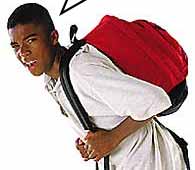

Influence of Carrying Book Bags
on Gait Cycle and Posture of YouthsThis section is compiled by Frank M. Painter, D.C.
Send all comments or additions to: Frankp@chiro.org




FROM: Ergonomics 1997 (JUn); 40 (6): 631–641
Pascoe DD, Pascoe DE, Wang YT, Shim DM, Kim CK
Department of Health and Human Performance,
Auburn University, AL 36849, USA
The purpose of this investigation was to determine the impact of different methods of carrying book bags on static posture and gait kinematics of youths aged 11-13 years. Surveys identified group descriptive characteristics of subjects and book bags. Ten subjects representing the best composite of the mean characteristics of this population were filmed for both static posture and dynamic conditions of one stride length. Subjects participated in four conditions: without bag (WO), one-strap backpack (1BP), two-strap backpack (2BP), and one-strap athletic bag (ATH). Lateral spinal deviation was not significantly different between 2BP and WO. However, differences (+/-SE) were observed between 1BP (8.5 +/- 0.7 degrees) and ATH (8.3 +/- 2.4 degrees) as compared with WO (1.9 +/- 0.5 degrees). Shoulder elevation from a horizontal position showed no difference between WO and 2BP. Without bag (2.0 +/- 0.9 degrees) was different from 1BP (17.6 +/- 1.8 degrees) and ATH (15.6 +/- 2.1 degrees). 1BP was also different from 2BP (3.4 +/- 1.1 degrees). Bag carrying significantly decreased stride length (1.59 +/- 0.04 m) and increased stride frequency (57.36 +/- 1.6 cycles/min) compared to WO (1.72 +/- 0.06 m; 54.64 +/- 1.2 cycles/min, respectively), thereby reducing the support phase of the gait.
One-strap bags (1BP, ATH) promoted lateral spinal bending and shoulder elevation, while the two-strap backpack significantly reduced these book bag carrying stresses. ATH promoted greater angular motion of the head and trunk as compared to backpack book bags. Carrying a backpack (1BP, 2BP) promoted significant forward lean of head and trunk compared to ATH or WO.
In conclusion, the daily physical stresses associated with carrying book bags on one shoulder (1BP, ATH) significantly alters the posture and gait of youth.

Return to BACKPACKS
Since 10-07-2000


| Home Page | Visit Our Sponsors | Become a Sponsor |
Please read our DISCLAIMER |
